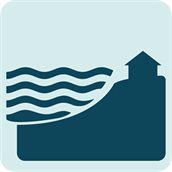Trends & projections for coastal and fluvial floods
This section describes historical trends and future projections for climate-related hazards in the Netherlands, affecting coastal and fluvial flooding. Apart from changes in climate-related hazards, flood risk also depends on exposure and vulnerability. Please refer to the risk assessment guidance page for more information.
Sea level rise
Climate change and rising temperatures cause ice sheets to melt and seawater to expand, leading to sea level rise. The Royal Netherlands Meteorological Institute (KNMI)(PDF) has calculated that sea levels in the Netherlands have risen by 25 centimetres since 1890. Moreover, sea level rise in the Netherlands is accelerating from 1.8 millimetres per year between 1890 and 1993 to 2.9 millimetres per year between 1993 and 2021.
KNMI has also projected future sea level rise for the Netherlands under two greenhouse gas emission scenarios: a low emission and a high emission scenario. These are denoted by the Shared Socioeconomic Pathways (SSPs) (see Dutch climate scenarios for more information).
- Low emission scenario (SSP1-2.6): Global temperatures are projected to rise about 1.7 degrees Celsius by 2100, compared to 1850-1900. This would result in a projected sea level rise of 26 to 73 centimetres along the Dutch coast by 2100, and 16 to 34 centimetres by 2050, compared to 1995-2014.
- High emission scenario (SSP5-8.5): Global temperatures are projected to increase by about 4.9 degrees Celsius by 2100, compared to 1850-1900. This would lead to a projected sea level rise of 59 to 124 centimetres by 2100, and 19 to 38 centimetres by 2050, compared to 1995-2014.
Change in river discharge
Precipitation, evaporation, and glacier melt influence river discharge volumes in the Netherlands. KNMI reports (PDF) that annual precipitation in the Netherlands has increased by 20% since the early 1900s. This has contributed to greater river discharges, especially in winter.
KNMI projects that winter precipitation will continue to increase in the future, leading to greater river discharges. Summers, on the other hand, are projected to become drier, resulting in lower river discharges. Therefore, KNMI's future projections (PDF) for annual discharge levels in the Rhine and Meuse rivers show no clear overall change, although seasonal differences exist: higher peaks in winter, lower discharges in summer. However, the annual maximum discharges for both rivers are projected to increase, particularly under the high emission scenario.
The influence of storms on floods
KNMI projections (PDF) indicate that future wind speeds in the Netherlands will remain similar to current levels. This means that storms and storm surges are unlikely to raise water levels higher than they do today. However, average sea levels will be higher. This, combined with increased river discharge volumes, will result in higher water levels in parts of the rivers that are influenced by sea level, as is explained on the Climate Adaptation Knowledge Portal. The extent to which this influences flood risk will depend on the effectiveness of coastal protection and protection of rivers in the Netherlands.

